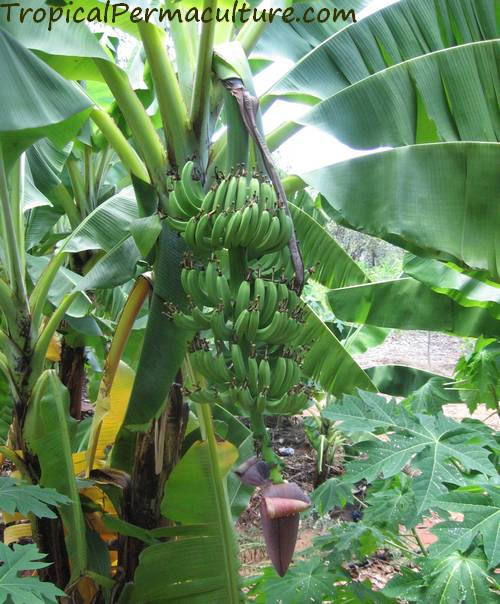How Long Do Bananas Take to Grow? A Complete Guide to Banana Growth Time and Care

Bananas are not only a delicious and nutritious fruit but also a fascinating crop to grow. Many gardening enthusiasts wonder, How long do bananas take to grow? This comprehensive guide delves into the growth timeline of banana plants, from planting the initial sucker to harvesting ripe fruit. We'll explore the various factors that influence growth time, including climate, care, and genetic variety. Understanding the stages of banana growth will help you cultivate this tropical gem successfully, whether you're a seasoned gardener or a beginner. Join us on this journey to discover the care and patience required to enjoy your very own banana harvest.
How Long Do Bananas Take to Grow?
Bananas typically take about 9 to 12 months from planting to harvest, depending on the variety and climate conditions. The growing process begins with planting a banana sucker or an established corm, and following a series of growth stages including leaf development and flower emergence. These stages are influenced by factors such as temperature, soil quality, and water availability, which can either accelerate or slow down growth. The fruit will take around 75 to 80 days to mature after the flowers appear, making patience essential for those cultivating bananas.
1. Planting Banana Plants
The first step in growing bananas is to select the right planting method, which generally involves using suckers or corms. It is crucial to plant these in well-draining soil with adequate sunlight to promote healthy growth. Most banana plants thrive in warm, tropical climates, requiring temperatures between 75°F and 95°F (24°C - 35°C) to establish a strong foundation for growth.
2. Growth Stages of Banana Plants
After planting, banana plants undergo several growth stages, starting with the development of leaves that form a pseudo-stem. Each leaf can grow up to 10 feet in length, and the plant will continue to accumulate leaves until it reaches its mature height. This phase generally lasts 3 to 6 months, after which flowering begins, leading to the next stage of producing fruit.
3. Timeframe for Flowering
Once the banana plant has reached maturity, it will produce a flowering spike that bears both male and female flowers. This process typically occurs around 6 to 8 months after planting, depending on the growing conditions. The male flowers bloom first, followed by the female flowers which form the actual bananas. After the flowers emerge, it takes about 75 to 80 days for the bananas to grow and ripen.
4. Factors Influencing Growth Rate
Several factors can significantly influence how long bananas take to grow. These include soil fertility, humidity, temperature fluctuations, and water availability. For instance, plants grown in nutrient-rich soil with consistent moisture tend to grow faster and yield more fruit. Additionally, temperature extremes can hinder growth, making it essential to maintain favorable conditions throughout the growing period.
5. Harvesting Bananas
Finally, when the bananas appear, they require about 75 to 80 days to mature after blooming. Farmers and gardeners must observe the changes in color and firmness to determine the right time for harvesting. Bananas are usually harvested while still green and allowed to ripen off the plant, ensuring optimal quality and flavor during consumption.
| Growth Stage | Duration |
|---|---|
| Planting | 0 months |
| Leaf Development | 3 to 6 months |
| Flowering | 6 to 8 months |
| Fruit Development | 75 to 80 days |
| Total Time to Harvest | 9 to 12 months |
How many bananas do you get from one plant?
The number of bananas you can get from one banana plant typically varies, but on average, a single plant can produce between 40 to 100 bananas per bunch. Each bunch, depending on the variety of the banana, can weigh anywhere from 50 to 150 pounds (22 to 68 kilograms). However, it's important to note that the exact yield can depend on several factors such as the health of the plant, the growing conditions, and the specific variety of the banana.
Factors Affecting Banana Yield
The yield of bananas from a single plant is influenced by several factors:
See also:
- Soil Quality: Nutrient-rich soil contributes positively to the growth and yield of the plant.
- Water Supply: Proper irrigation is essential; both under-watering and over-watering can hinder the production of bananas.
- Climate Conditions: Bananas thrive in tropical climates with stable temperatures; extreme weather can affect yield.
Banana Plant Life Cycle
Understanding the life cycle of a banana plant helps explain its yield:
- Vegetative Stage: This is when the plant grows leaves and roots, generally lasting several months.
- Flowering Stage: After establishing significant growth, the plant produces flowers, leading to fruit development.
- Fruit Maturation: The bananas take several months to mature, typically around 75-80 days after flowering.
Types of Banana Varieties
Different varieties of bananas yield varying amounts and sizes:
- Cavendish: The most common variety, generally producing larger bunches with many individual bananas.
- Red Bananas: These produce smaller bunches but have a unique flavor and color.
- Plantains: Often larger and starchier, they can also yield a significant amount but are used differently compared to sweet bananas.
Harvesting Techniques
The method of harvesting can influence the effective yield:
- Timing: Harvesting at the right time is crucial for maximizing quality and quantity.
- Manual vs. Mechanical: Manual harvesting can result in less damage to the plant and better yields, while mechanical methods can improve efficiency.
- Post-Harvest Handling: Proper handling can prevent spoilage and increase marketable yield.
Estimated Production in Commercial Farming
In commercial farming settings, the yield can vary significantly:
- Intensive Cultivation: Some commercial growers manage to get more than 100 bananas per plant through careful farming practices.
- Organic Practices: Organic farms may yield less but produce higher quality fruits.
- Climate-Controlled Environments: Farms using technology to control environment can maximize yields per plant.
How long do bananas take to mature after flowering?
:max_bytes(150000):strip_icc()/20240520-SEA-BananaHowtoRipen-group-5f30658b7582438b90492432a8e698f2.jpg)
After flowering, bananas typically take about 75 to 80 days to mature. This maturation period can vary slightly based on several factors, including the variety of the banana, environmental conditions, and agricultural practices. Once the banana plants flower, they begin to develop fruit, which continues to grow in size and gradually changes in color from green to yellow as it ripens.
Factors Affecting Maturation Time
The maturation time of bananas can be influenced by various conditions.
- Climate: Warmer temperatures generally speed up the ripening process while cooler climates can delay it.
- Soil Quality: Nutrient-rich soil promotes healthier growth and potentially faster maturation.
- Water Supply: Adequate water is crucial; both drought and waterlogging can adversely affect fruit development.
Banana Plant Varieties
There are numerous varieties of bananas, each with unique maturation characteristics.
- Cavendish: This is the most common commercial variety and usually takes about 75-80 days from flowering to harvest.
- Red Bananas: These varieties may take longer to mature compared to Cavendish, sometimes stretching to 90 days.
- Plantains: These are starchier and can require additional time, often taking up to 100 days depending on the climate.
Environmental Conditions
The environmental conditions surrounding the banana plants play a significant role in how quickly they mature.
- Sunlight: Ample sunlight is necessary for photosynthesis, promoting faster growth and maturation.
- Humidity: High humidity levels can enhance growth rates, whereas too little can stress the plant.
- Wind Exposure: Frequent strong winds can damage the flower or fruit, leading to prolonged maturation times.
Cultivation Practices
Agricultural practices can greatly influence banana maturation times and overall plant health.
See also:
- Fertilization: Providing essential nutrients can accelerate growth and improve fruit quality.
- Pest Control: Protecting the plants from pests and diseases is vital for ensuring healthy maturation.
- Pruning: Removing dead leaves and excess growth can allow the plant to focus energy on fruit development.
Post-Flowering Development
The period following flowering is critical for the development of bananas.
- Fruit Cell Expansion: During the first few weeks after the flower blossoms, cells within the fruit multiply and expand.
- Color Change: As the fruit matures, it will start to change from green to yellow, indicating ripeness.
- Flavor Development: The sugars in the fruit increase during maturation, impacting the flavor profile when harvested.
How difficult is it to grow bananas?

Growing bananas can be a rewarding yet challenging endeavor. The difficulty of cultivating bananas largely depends on various factors, including climate, soil conditions, and pest management. Here’s a detailed look into the complexities of growing bananas.
Climate Requirements
Bananas thrive in warm, tropical climates which significantly influence their growth. They require a consistent temperature of around 78°F to 86°F (25°C to 30°C) for optimal growth.
- Temperature: Too cold can stunt growth, while extreme heat can damage the plants.
- Humidity: High humidity levels are essential, ideally between 50% and 70%.
- Rainfall: Adequate rainfall, about 40 inches annually, is necessary, with well-drained soil to prevent flooding.
Soil Conditions
The soil quality directly impacts the success of banana cultivation. Bananas prefer loamy, well-draining soil rich in organic matter to support their rapid growth.
- pH Levels: An optimal soil pH of 5.5 to 7 is crucial to nutrient absorption.
- Drainage: Good drainage is vital to prevent root rot and ensure the health of the plants.
- Nutrients: Regular applications of fertilizers high in potassium can enhance fruit quality and yield.
Pest and Disease Management
Banana plants are susceptible to various pests and diseases that can hinder their growth and fruit production. Managing these threats is critical for successful cultivation.
- Common Pests: Aphids, weevils, and nematodes can damage banana plants.
- Diseases: Diseases like Panama disease and Black Sigatoka can devastate crops if not managed properly.
- Preventive Measures: Implementing integrated pest management (IPM) strategies is essential to help protect the plants.
Watering Needs
Bananas require a significant amount of water, making irrigation a key aspect of their cultivation. Ensuring proper watering routines can affect growth rates and fruit yield.
- Watering Frequency: Regular watering, especially during dry spells, is crucial to prevent stress on the plants.
- Soil Moisture: Consistent soil moisture levels are necessary without causing waterlogging.
- Irrigation Techniques: Employing drip irrigation can optimize water usage and prevent diseases.
Harvesting Challenges
Harvesting bananas presents its own set of challenges, from determining the right time to cut the fruit to managing the logistics of transport.
- Timing: Bananas are typically harvested when they are still green, which requires skill to assess ripeness.
- Transport: The fruits are sensitive and need careful handling to avoid bruising during transport.
- Post-Harvest Care: Proper storage conditions are vital to prolong shelf life and quality.
Questions from Our Readers
How long does it take for a banana plant to mature?
The average time for a banana plant to mature and produce fruit is typically 9 to 12 months after planting. This timeframe can vary based on factors like variety, climate, and care provided to the plant.
What factors affect the growth time of bananas?
Several factors can influence the growth time of bananas, including soil quality, temperature, rainfall, and the specific banana variety being grown. These elements collectively impact how quickly the plant can reach its fruit-bearing stage.
See also:
Do bananas ripen on the plant or after harvesting?
Bananas generally ripen after being harvested rather than while still on the plant. They are usually picked while they are still green and allowed to ripen at room temperature, which can take several days to a week.
How often should I water banana plants for optimal growth?
For optimal growth, banana plants should be watered regularly to keep the soil consistently moist but not waterlogged. A good rule of thumb is to provide about 1 to 2 inches of water per week, adjusting as necessary based on weather conditions.

If you want to read more articles like How Long Do Bananas Take to Grow? A Complete Guide to Banana Growth Time and Care, we recommend you check out our Plants category.
Leave a Reply
Related Articles